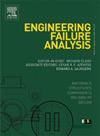扭转疲劳失效建模与试验研究
IF 4.4
2区 工程技术
Q1 ENGINEERING, MECHANICAL
引用次数: 0
摘要
基于连续损伤力学,建立了用于疲劳寿命预测的弹塑性损伤模型,并对18CrNiMo7-6钢扭转试样的疲劳特性进行了实验研究。建立了考虑非线性各向同性/运动硬化的损伤耦合弹塑性本构模型,并对材料参数进行了标定。引入了一种损伤变量耦合弹塑性构件,并通过扭转疲劳试验得到了相应的损伤参数,置信度为80%。建立了有限元模型,预测寿命与实验寿命误差均在三倍误差范围内,验证了弹塑性损伤模型的正确性。揭示了损伤演化规律和损伤弱化效应。结果表明,低荷载下的纯弹性损伤削弱了局部屈服能力,从而导致后续阶段的塑性损伤。运动硬化在早期达到了152 MPa的饱和应力,而各向同性软化需要更高的塑性应变才能达到115 MPa的饱和应力。裂纹在最大八面体剪切应力区开始,导致轮廓光滑的瞬时断裂(≤70%临界扭矩)或5-20µm韧窝的延性撕裂(≥80%临界扭矩)。建议寿命因子ZNT≥1.21,以进一步缩小标准建议的设计范围。本文章由计算机程序翻译,如有差异,请以英文原文为准。

Modeling of torsional fatigue failure and experimental investigation
In this study, an elastic–plastic damage model for fatigue life prediction is developed based on continuum damage mechanics, and the fatigue characteristics of torsion specimens of 18CrNiMo7-6 steel are investigated experimentally. A damage-coupled elastic–plastic constitutive model considering non-linear isotropic/kinematic hardening is established, and the material parameters are calibrated. A damage variable coupling elastic and plastic components is introduced, and corresponding damage parameters are obtained from torsional fatigue tests with an 80 % confidence level. A finite element model is established, and the errors of predicted and experimental lives are within the triple error band, validating the correctness of the elastic–plastic damage model. The damage evolution laws and weakening effects of damage are revealed. The results indicate that purely elastic damage under lower loads weakens local yield capacity and consequently leads to plastic damage in the following stage. Kinematic hardening achieves saturation stress of 152 MPa at an early stage, while isotropic softening requires higher plastic strain to attain saturation at 115 MPa. Cracks initiate at maximum octahedral shear stress zone, resulting in instantaneous fracture with smooth contour (at ≤70 % critical torque) or ductile tearing with 5–20 µm dimples (at ≥80 % critical torque). A life factor ZNT ≥ 1.21 is recommended to further narrow the design range beyond that suggested by the standards.
求助全文
通过发布文献求助,成功后即可免费获取论文全文。
去求助
来源期刊

Engineering Failure Analysis
工程技术-材料科学:表征与测试
CiteScore
7.70
自引率
20.00%
发文量
956
审稿时长
47 days
期刊介绍:
Engineering Failure Analysis publishes research papers describing the analysis of engineering failures and related studies.
Papers relating to the structure, properties and behaviour of engineering materials are encouraged, particularly those which also involve the detailed application of materials parameters to problems in engineering structures, components and design. In addition to the area of materials engineering, the interacting fields of mechanical, manufacturing, aeronautical, civil, chemical, corrosion and design engineering are considered relevant. Activity should be directed at analysing engineering failures and carrying out research to help reduce the incidences of failures and to extend the operating horizons of engineering materials.
Emphasis is placed on the mechanical properties of materials and their behaviour when influenced by structure, process and environment. Metallic, polymeric, ceramic and natural materials are all included and the application of these materials to real engineering situations should be emphasised. The use of a case-study based approach is also encouraged.
Engineering Failure Analysis provides essential reference material and critical feedback into the design process thereby contributing to the prevention of engineering failures in the future. All submissions will be subject to peer review from leading experts in the field.
 求助内容:
求助内容: 应助结果提醒方式:
应助结果提醒方式:


